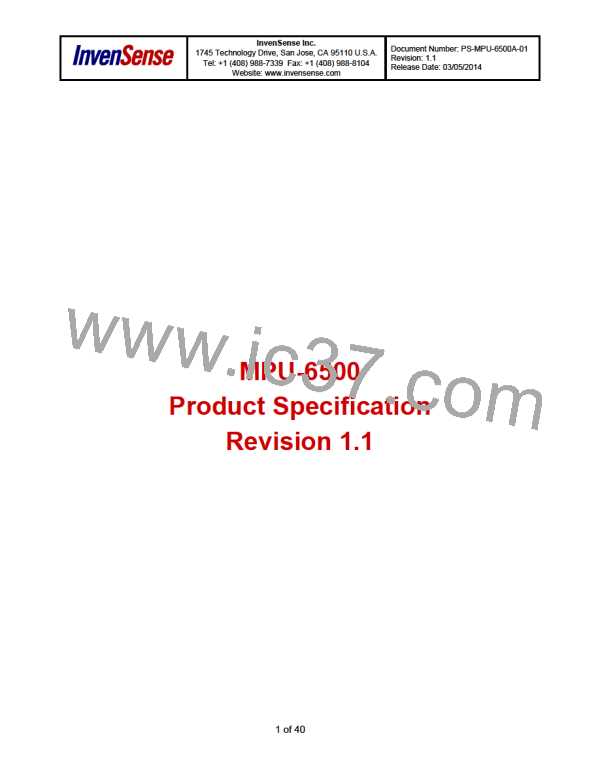Document Number: PS-MPU-6500A-01
Revision: 1.1
Release Date: 03/05/2014
MPU-6500 Product Specification
2
Features
2.1 Gyroscope Features
The triple-axis MEMS gyroscope in the MPU-6500 includes a wide range of features:
•
Digital-output X-, Y-, and Z-axis angular rate sensors (gyroscopes) with a user-programmable full-
scale range of ±250, ±500, ±1000, and ±2000°/sec and integrated 16-bit ADCs
Digitally-programmable low-pass filter
Gyroscope operating current: 3.2mA
Factory calibrated sensitivity scale factor
•
•
•
•
Self-test
2.2 Accelerometer Features
The triple-axis MEMS accelerometer in MPU-6500 includes a wide range of features:
•
Digital-output X-, Y-, and Z-axis accelerometer with a programmable full scale range of ±2g, ±4g,
±8g and ±16g and integrated 16-bit ADCs
•
•
•
•
•
Accelerometer normal operating current: 450µA
Low power accelerometer mode current: 6.37µA at 0.98Hz, 17.75µA at 31.25Hz
User-programmable interrupts
Wake-on-motion interrupt for low power operation of applications processor
Self-test
2.3 Additional Features
The MPU-6500 includes the following additional features:
•
•
•
•
•
•
•
•
•
•
•
•
•
•
•
Auxiliary master I2C bus for reading data from external sensors (e.g. magnetometer)
3.4mA operating current when all 6 motion sensing axes are active
VDD supply voltage range of 1.8 – 3.3V ± 5%
VDDIO reference voltage of 1.8 – 3.3V ± 5% for auxiliary I2C devices
Smallest and thinnest QFN package for portable devices: 3x3x0.9mm
Minimal cross-axis sensitivity between the accelerometer and gyroscope axes
512 byte FIFO buffer enables the applications processor to read the data in bursts
Digital-output temperature sensor
User-programmable digital filters for gyroscope, accelerometer, and temp sensor
10,000 g shock tolerant
400kHz Fast Mode I2C for communicating with all registers
1MHz SPI serial interface for communicating with all registers
20MHz SPI serial interface for reading sensor and interrupt registers
MEMS structure hermetically sealed and bonded at wafer level
RoHS and Green compliant
2.4 MotionProcessing
•
Internal Digital Motion Processing™ (DMP™) engine supports advanced MotionProcessing and low
power functions such as gesture recognition using programmable interrupts
In addition to the angular rate, this device optionally outputs the angular position (angle).
Low-power pedometer functionality allows the host processor to sleep while the DMP maintains the
step count.
•
•
8 of 40

 TDK [ TDK ELECTRONICS ]
TDK [ TDK ELECTRONICS ]